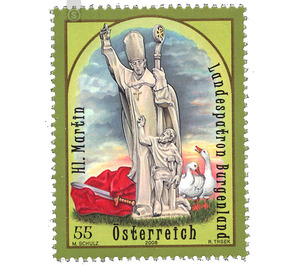patrons - Austria / II. Republic of Austria 2008 - 55 Euro Cent
Theme: Religion & Spirituality
| Country | Austria / II. Republic of Austria |
| Issue Date | 2008 |
| Face Value | 55.00 |
| Edition Issued | 500,000 |
| Printing Type | combination printing |
| Stamp Type | Commemorative |
| Item Type | Stamp |
| Chronological Issue Number | 2120 |
| Chronological Chapter | OOS-OE2 |
| SID | 824083 |
| In 56 Wishlists | |
No doubt: Saint Martin is one of the most famous and also "most popular" saints of the Catholic Church (which, moreover, is also worshiped in the Protestant, Anglican and Orthodox Churches). History: Martin of Tours, so his "bourgeois" name, lived from about 316 to 397. He was effectively the "link" between Rome and the Kingdom of the Franks. As an ascetic monk he embodied the late antique ideal of a priest or bishop - and the rapid awareness, first in its narrow sphere of action, is due to his virtues as a helper and miracle worker. On 4 July 372 he was finally consecrated bishop of Tours. Instead of living in the city, however, he preferred the wooden huts in front of the city walls, where the monastery of Saint-Martin de Ligugé was built during his lifetime. Interesting: Martin was after Mary, the mother of Jesus, and the apostle John the first saint of the West, who did not die martyred. Thus, he became the first saint of a new, then unknown type: Until then, a Christian could achieve holiness only through a martyrdom, it was now clear that holiness can also exist in a moral way of life and acts of charity and mercy. However, the most famous event in the life of Saint Martin is the following: From the year 334 Martin was stationed as a soldier of the cavalry of the Imperial Guard in Amiens. The guardsmen wore at that time the so-called "Chlamys", a white cloak of two parts. One day in the winter, Martin met a poor, unclothed man at the city gate of Amiens. Martin was not carrying anything except his weapons and the military coat. In a benevolent act, he divided his cloak with the sword and gave half to the poor. The following night, in the dream, Jesus Christ appeared, clothed in the half-cloak Martin had given to the beggar. In the sense of Matthew - "I was naked and you clothed me. What you have done to one of my lesser brothers you have done to me "- Martin proves to be a disciple of Jesus here. As patron saint of Burgenland, Saint Martin enjoys a great reputation. But not only here: On "Martinstatte", the 11th of November, the "Laternderlfest", which is especially popular with children, is celebrated in numerous villages throughout Austria with a festive procession. The traditional "Martinigansl" is also a lovingly cultivated tradition and year after year a fixture in the "gastronomic calendar of the year".


